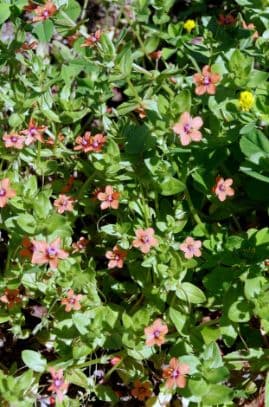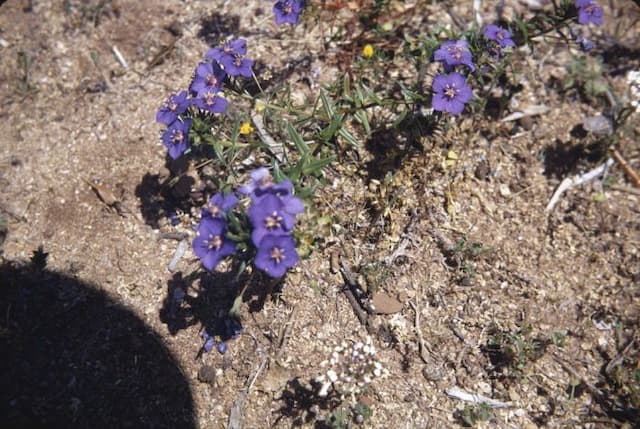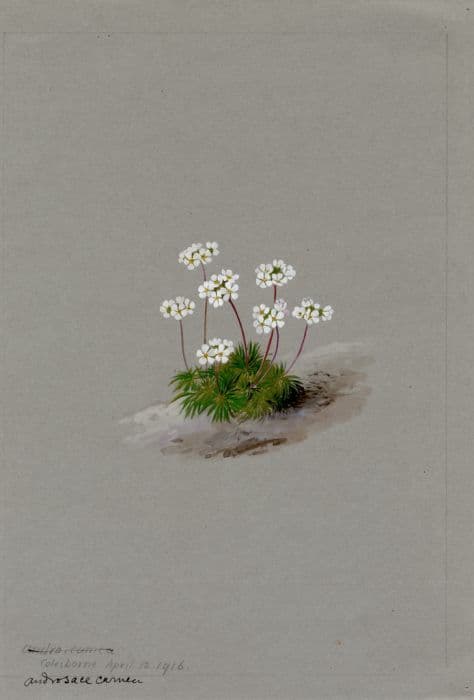Ivy-leaved cyclamen Cyclamen hederifolium var. hederifolium f. albiflorum

ABOUT
The plant in discussion, commonly known as ivy-leaved cyclamen, is known for its ornamental features, which include heart-shaped leaves with a distinctive ivy-like appearance. These leaves are usually dark green in color and patterned with silver and white tones, marked with intricate veining that adds to their aesthetic appeal. The plant produces flowers that are pure white in color, making it a striking variety among its kind. The blooms have an elegant, upswept shape that resembles a group of butterflies hovering above the foliage. The petals are soft and silky to the touch, gently curving upwards, creating a sense of delicate grace. This plant typically blooms in the late summer to autumn period, adding a splash of brightness as many other plants begin to fade. Its overall appearance is charming and can bring a touch of refined beauty to any garden setting where color and leaf texture are valued.
About this plant
 Names
NamesSynonyms
Ivy-leaved Cyclamen, Sowbread, European Cyclamen, Groundbread, Swine Bread, Persian Violet, Alpine Violet.
Common names
Cyclamen neapolitanum, Cyclamen hederifolium.
 Toxicity
ToxicityTo humans
The Cyclamen, specifically Cyclamen hederifolium, commonly known as ivy-leaved cyclamen or sowbread, contains toxic saponins. If ingested by humans, the plant parts, particularly the tubers, can cause symptoms such as vomiting, diarrhea, and abdominal pain. Ingesting any part of the plant should be avoided to prevent these unpleasant and potentially harmful effects.
To pets
Cyclamen, or ivy-leaved cyclamen, is toxic to pets, including dogs and cats. The plant, especially the tubers, contains saponins that can cause symptoms if ingested. These symptoms include salivation, vomiting, diarrhea, and in severe cases, it can lead to heart rhythm abnormalities, seizures, and even death. It is important to keep this plant out of reach of pets to avoid accidental ingestion.
 Characteristics
CharacteristicsLife cycle
Perennials
Foliage type
Deciduous
Color of leaves
Varies
Flower color
White
Height
4 inches (10 cm)
Spread
6 inches (15 cm)
Plant type
Bulb
Hardiness zones
5
Native area
Mediterranean
Benefits
 General Benefits
General Benefits- Aesthetic Appeal: Adds visual interest to gardens with its white flowers and attractive, ivy-like leaves.
- Seasonal Interest: Blooms in late summer to autumn, providing color and life when many other plants start to decline.
- Low Maintenance: Requires minimal care once established, making it an ideal choice for beginner gardeners or those with limited time.
- Drought Tolerance: Once established, it can tolerate dry conditions, reducing the need for frequent watering.
- Deer Resistant: Typically not favored by deer, which helps protect it in areas where deer browsing can be a problem.
- Attracts Pollinators: Flowers can attract bees and other pollinating insects, contributing to the health of the garden ecosystem.
- Naturalising: Has the ability to self-seed and spread over time, creating natural drifts of color in the landscape.
- Non-Invasive: Unlike some other garden plants, it spreads slowly and is unlikely to become problematic or overtake other plants.
 Medical Properties
Medical PropertiesThis plant is not used for medical purposes.
 Air-purifying Qualities
Air-purifying QualitiesThis plant is not specifically known for air purifying qualities.
 Other Uses
Other Uses- Cyclamen hederifolium, commonly known as ivy-leaved cyclamen, dried tubers can be ground to make a laundry starch that was traditionally used for stiffening clothes.
- The ivy-leaved cyclamen's tubers have been used as a soap substitute due to their saponin content; crushed tubers would be mixed with water to create a soapy lather.
- With its aesthetic appeal, the plant can be used in botanical art and illustrations, capturing the delicate beauty of its flowers and foliage.
- The plant is sometimes used as a natural dye source, with the potential to produce subtle coloring for fabrics and yarns.
- As a decorative motif, ivy-leaved cyclamen has inspired patterns in textiles, wallpaper, and fine china designs due to its attractive foliage and flower shape.
- Ivy-leaved cyclamen can function as a companion plant in gardens, helping to deter pests from more vulnerable plants with its mildly toxic nature.
- Its flowers can be crystallized and used as edible decorations for cakes and desserts, though it's essential to ensure they are free from pesticides and other chemicals.
- In certain cultures, the ivy-leaved cyclamen has been a symbol in storytelling and folklore, representing sincere love and affection.
- During Victorian times, ivy-leaved cyclamen was a popular addition to table arrangements and boutonnieres for its ornamental value.
- The plant can contribute to a sensory garden design, providing a variety of textures, colors, and scents to engage the senses.
Interesting Facts
 Feng Shui
Feng ShuiThe Cyclamen is not used in Feng Shui practice.
 Zodiac Sign Compitability
Zodiac Sign CompitabilityThe Cyclamen is not used in astrology practice.
 Plant Symbolism
Plant Symbolism- Deep Love: Cyclamen is often associated with deep, everlasting love due to its heart-shaped leaves and long-lasting flowers.
- Sincerity: The simple, elegant appearance of the cyclamen blooms is thought to represent sincerity and genuine feelings.
- Goodbye: In some cultures, giving someone a cyclamen plant symbolizes a parting or end of a relationship as it can symbolize a respectful goodbye or resignation.
- Shyness: The way cyclamen flowers seem to bow their heads could be seen as a symbol of shyness or modesty.
- Maternal Love: The nurturing growth habit and protective nature of the cyclamen's tubers are often associated with a mother’s tenderness and care.
 Water
WaterIvy-leaved cyclamen requires moderate watering during active growth in the fall and winter, with a reduction in watering after the foliage begins to yellow and die back in the spring. Aim for keeping the soil evenly moist but not soggy, allowing the top inch of soil to dry out between waterings. You might water with approximately 1 gallon per week depending on the size of your plant and the dryness of the environment but always adjust based on soil moisture levels. During dormancy in the summer, water sparingly, only enough to prevent the tubers from completely drying out, which might be a light watering every few weeks.
 Light
LightFor the ivy-leaved cyclamen, bright, indirect light is ideal. Avoid direct sunlight, especially in hot summer months, as it can burn the leaves. A north or east-facing window with filtered light is an excellent spot for this plant to thrive while providing the lighting conditions it needs without the harsh effects of the direct sun.
 Temperature
TemperatureIvy-leaved cyclamen prefers cooler temperatures, ideally between 60°F and 70°F, during its active growth period in the fall and winter. It can tolerate a minimum temperature of around 50°F at night. Avoid exposing the plant to temperatures above 77°F, as hotter conditions can lead to the plant going dormant prematurely. Keeping the cyclamen in a cool location away from heat sources like radiators is crucial.
 Pruning
PruningPruning the ivy-leaved cyclamen is mainly about removing dead or yellowing leaves to encourage new growth and maintain a tidy appearance. This should be done periodically, especially as the leaves start to die back in the spring. The best time to prune is after flowering when the foliage begins to fade. Removing old flowers can also prevent disease and encourage more blooms during the next growing season.
 Cleaning
CleaningAs needed
 Soil
SoilThe ideal soil mix for Ivy-leaved cyclamen, a common name for Cyclamen hederifolium, is one that is well-draining and fertile, with a mix of potting soil, peat, and perlite or sand. The soil pH should be slightly acidic to neutral, ranging between 6.5 and 7.2.
 Repotting
RepottingIvy-leaved cyclamen should be repotted approximately every one to two years. The best time to repot is when the plant is dormant, typically after the foliage dies back.
 Humidity & Misting
Humidity & MistingIvy-leaved cyclamen prefers moderate humidity levels but can tolerate lower humidity. It thrives best when humidity is kept around 50-60%.
 Suitable locations
Suitable locationsIndoor
Place Ivy-leaved cyclamen in bright, indirect light inside.
Outdoor
Plant Ivy-leaved cyclamen in dappled shade outdoors.
Hardiness zone
5-9 USDA.
 Life cycle
Life cycleIvy-leaved cyclamen (Cyclamen hederifolium var. hederifolium f. albiflorum), begins its life as a seed that germinates in spring, forming a small tuber. Over time, the tuber develops into a mature plant, from which heart-shaped leaves emerge in late summer or early autumn. The leaves are followed by the distinctive white flowers that blossom in autumn, continuing into winter. After pollination, usually by insects, the plant produces seed pods that bend toward the ground, releasing seeds as they mature. The leaves die back in late spring as the plant enters dormancy during the summer months to conserve energy. With the return of cooler temperatures in late summer, the cycle restarts with the emergence of new leaves, continuing the annual growth cycle of the plant.
 Propogation
PropogationPropogation time
Late summer to early fall
Cyclamen hederifolium, commonly known as ivy-leaved cyclamen, is most commonly propagated by seed. To propagate by seed, the process should begin shortly after the seeds are ripe, which usually happens in late spring to early summer. The collected seeds should be sown in trays or pots filled with a well-drained potting mix. They should be covered lightly with soil and kept at a steady temperature of around 59-68 degrees Fahrenheit (15-20 degrees Celsius). It is important to maintain a moist environment but not waterlogged, as too much moisture can cause the seeds to rot. Germination can be slow and erratic, but once the seedlings develop true leaves, they can be carefully transplanted into individual pots. It typically takes a few years for seed-grown plants to flower.









